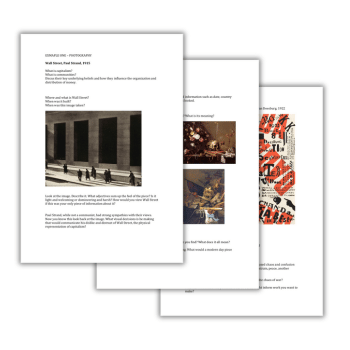This pack focuses on contextual research in art and supports the building of discussion skills. It will help students build their analytical and contextual understanding. Each section acts as a stand-alone discussion and places the art into a wider context.
Topics covered
- Photography
- Graphic communication and DADA
- Fine art
What is contextual research in art?
Contextual research in art involves exploring the background, influences and broader context behind a piece of art or an artistic movement.
This can include researching the cultural, historical, social and political factors that shaped the artwork, as well as the artist’s life, intentions and personal experiences.
This involves not just looking at the artwork itself but understanding the bigger picture:
- What was happening in the world when it was created?
- What was the artist responding to?
- How did other artists or movements influence their work?
This research helps to deepen your understanding and interpretation of the art.
Example discussion
Artwork: Wall Street, Paul Strand (1915)
Look at the image. Describe it. What adjectives sum up the feel of the piece? Is it light and welcoming or domineering and harsh? How would you view Wall Street if this was your only piece of information about it?
Paul Strand, while not a communist, had strong sympathies with their views. Now you know this, look back at the image. What visual decisions is he making that would communicate his dislike and distrust of Wall Street, the physical representation of capitalism?
Points to consider:
- What are the people doing? How they are shown?
- Think about the perspective/angle of the shot
- Consider the scale of people versus building
- Put Wall Street into a search engine. How is it shown in the images that come up?
- What symbols can you see? What do these images suggest about Wall Street?
Hannah Day is head of art, media and film at Ludlow College.














